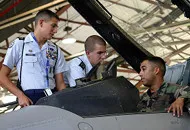Table of Contents
Thankfully, the Hennessy administration has made serious efforts to discuss options with the military concerning the reinstatement of an ROTC chapter at Stanford. But Hennessy recently reported in a faculty senate meeting that it is unlikely for Stanford to receive a chapter, because the military will still be constrained by budgetary concerns. The Review Editorial Board affirms the administration’s efforts, and strongly encourages the university to continue exploring options like offering credit for ROTC courses or even offering some of the courses at Stanford.
But while President Hennessy and the university pursues these options, students should also be willing to explore ROTC as a potential option, even if it still proves inconvenient to participate. If the military is ever to see Stanford as a viable option for a new chapter, Stanford must exhibit increased participation and a culture of supporting military service. In line with these requirements, we believe that freshmen and sophomores should seriously consider participating in ROTC. Their involvement will be beneficial to themselves, the university, and society in general.
For a participating student, ROTC can provide invaluable leadership experience. Many Stanford students know they will be in positions of leadership at some point during their professional careers. Many even see Stanford as a time to hone their leadership skills. Certainly Stanford’s plethora of student organizations provides an opportunity to develop leadership skills, but the military does as well. Fourth-year cadets must take charge of the rest of the cadets during training days, keeping the training on schedule, properly disciplining and encouraging, and making decisions with confidence.
As another personal benefit, participating in the program would provide students with a better sense of real world trials. As our generation struggles to shirk off the reputation given to us by author William Deresiewicz, that of being experts at hoop-jumping, participating in ROTC would force students to meet expectations and gain achievements without somehow playing the system. While Deresiewicz’s stereotype may be unfair or incorrect, if more students participated in ROTC, they could hopefully impact the entire Stanford culture by inculcating it with discipline and perseverance.
Many Stanford students might have trouble seeing how serving in the military could provide more value to society than working in other areas. But the military should not be excluded from the list of careers that add value to society. Value cannot just be judged through the foreign policy actions that the military participates in, though there are certainly convincing arguments for why national security adds, or perhaps protects, value in society. The military represents a diverse slice of society. At least for future Stanford officers, many of the people they would be leading come from backgrounds with which many Stanford students have never or would never have interacted. This interaction will naturally be beneficial for the student himself. But it will also be tremendously beneficial for society. Thousands of citizens serve in the military and then enter civilian society. An intermingling of classes, ideas, and backgrounds that includes Stanford students could only be beneficial to all involved.
Underclassmen must understand that ROTC is not immediately a permanent commitment. They can try it out in their freshmen or sophomore years and opt out if they do not want to continue.
Ultimately, with the faculty on board, it is time Stanford students jump on board with ROTC as well. It might be a culture shock for the cadets and for their circles of influence back on campus, but it is one that would serve the individuals participating, the student body, and society quite well.





